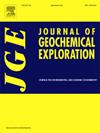稀土元素离子吸附粘土矿床的基本原理:一种矿物系统勘探方法
IF 3.3
2区 地球科学
Q1 GEOCHEMISTRY & GEOPHYSICS
引用次数: 0
摘要
对“绿色技术”的需求呈指数级增长,需要显著增加关键元素的产量,包括稀土元素(REE)。一些最重要(和最大)的稀土矿床与碳酸盐岩有关。然而,碳酸盐岩主要是轻(L)稀土富集,这对满足全球重(H)稀土需求具有重要意义。因此,稀土离子吸附粘土沉积物(IACD)作为强烈风化的例子,引起了国际上对三稀土元素来源的兴趣(全球约80%的三稀土元素来自IACD)。因此,本研究采用矿物系统的方法,对稀土元素IACD进行了全面的回顾,以了解它们的制约因素、全球分布和主要特征。IACD的稀土元素来源虽然通常是花岗岩,但比传统认为的更加多样化,当地火成岩、变质岩和沉积岩的风化作用以及外部流体(如热液流体和盆地盐水)和岩性(如风化成分的运输而不是原位来源)提供了IACD形成所需的稀土元素。随着富REE源物质的风化作用,REE通过与配体(如F−、CO32−、SO42−、PO43−)的ph依赖络合或作为水合REE物质在风化剖面中被释放和动员。来源的性质(如相对轻稀土或三稀土富集)和风化剖面内的流体(如pH值和配体浓度)控制着IACD的稀土分馏和相对轻稀土和三稀土富集。稀土元素一旦被调动,就会从溶液中吸附出来,并富集到粘土矿物(如高岭石和高岭土)上,这一过程受到pH值和粘土的物理化学特征的强烈控制,在环中性条件下,稀土元素的吸附最为有利。为了通过粘土吸附来保持稀土元素的富集(和IACD的形成),需要一个低侵蚀环境。降雨过多的气候(例如,热带潮湿气候)可能会对REE IACD在地质时期的保存造成问题,因为过量的降雨会导致粘土溶解和腐石崩塌。本研究提供的概念模型开发了一个框架,随着我们对这些矿床类型的了解和全球勘探的继续,该框架将在未来几年建立起来。本文章由计算机程序翻译,如有差异,请以英文原文为准。

The fundamentals of rare earth element ion adsorption clay deposits: A mineral systems approach for exploration
The exponential growth of demand for ‘green-technologies’ requires significantly increased production of critical elements, including rare earth elements (REE). Some of the most significant (and largest) REE deposits are associated with carbonatites. However, carbonatites are predominantly light-(L)REE-enriched, which has implications for meeting global heavy-(H)REE demand. As a result, REE ion adsorption clay deposits (IACD), which are examples of intense weathering, have sparked international interest as a HREE source (~80 % of global HREE are sourced from IACD). Therefore, this study presents a comprehensive review of REE IACD to understand their constraints, global distribution, and main features while applying a mineral systems approach.
The REE source for IACD, although typically granitic, is more diverse than traditionally thought, with the weathering of local igneous, metamorphic, and sedimentary rocks and external fluids (e.g., hydrothermal fluids and basinal brines) and lithologies (e.g., transport of weathering constituents rather than an in-situ source) supplying the REE required for IACD formation. Following the weathering of REE-rich source material, REE are liberated and mobilised in the weathering profile through pH-dependent complexation with ligands (e.g., F−, CO32−, SO42−, PO43−) or as hydrated REE species. The nature of the source (e.g., relative LREE- or HREE-enrichment) and fluids within the weathering profile (e.g., pH and ligand concentrations) control REE fractionation and relative LREE and HREE enrichment of a IACD. Once mobilised, REE are adsorbed out of solution and enriched onto clay minerals (e.g., kaolinite and halloysite), a process strongly controlled by pH and the physicochemical characteristics of the clays present, with REE adsorption most favourable under circumneutral conditions. To preserve REE enrichment (and IACD formation) through clay adsorption, a low erosional setting is required. Climates with excessive rainfall (e.g., tropical humid climates) may be problematic for REE IACD preservation through geological time, where excessive rainfall results in clay dissolution and saprolite collapse. The conceptual model provided in this study develops a framework that will be built upon in the coming years as our knowledge of these deposit types and global exploration continues.
求助全文
通过发布文献求助,成功后即可免费获取论文全文。
去求助
来源期刊

Journal of Geochemical Exploration
地学-地球化学与地球物理
CiteScore
7.40
自引率
7.70%
发文量
148
审稿时长
8.1 months
期刊介绍:
Journal of Geochemical Exploration is mostly dedicated to publication of original studies in exploration and environmental geochemistry and related topics.
Contributions considered of prevalent interest for the journal include researches based on the application of innovative methods to:
define the genesis and the evolution of mineral deposits including transfer of elements in large-scale mineralized areas.
analyze complex systems at the boundaries between bio-geochemistry, metal transport and mineral accumulation.
evaluate effects of historical mining activities on the surface environment.
trace pollutant sources and define their fate and transport models in the near-surface and surface environments involving solid, fluid and aerial matrices.
assess and quantify natural and technogenic radioactivity in the environment.
determine geochemical anomalies and set baseline reference values using compositional data analysis, multivariate statistics and geo-spatial analysis.
assess the impacts of anthropogenic contamination on ecosystems and human health at local and regional scale to prioritize and classify risks through deterministic and stochastic approaches.
Papers dedicated to the presentation of newly developed methods in analytical geochemistry to be applied in the field or in laboratory are also within the topics of interest for the journal.
 求助内容:
求助内容: 应助结果提醒方式:
应助结果提醒方式:


